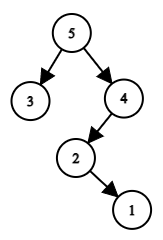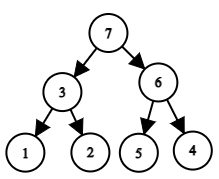Preparando MOJI
A permutation — is a sequence of length $$$n$$$ integers from $$$1$$$ to $$$n$$$, in which all the numbers occur exactly once. For example, $$$[1]$$$, $$$[3, 5, 2, 1, 4]$$$, $$$[1, 3, 2]$$$ — permutations, and $$$[2, 3, 2]$$$, $$$[4, 3, 1]$$$, $$$[0]$$$ — no.
Polycarp was recently gifted a permutation $$$a[1 \dots n]$$$ of length $$$n$$$. Polycarp likes trees more than permutations, so he wants to transform permutation $$$a$$$ into a rooted binary tree. He transforms an array of different integers into a tree as follows:
For example, if he builds a tree by permutation $$$a=[3, 5, 2, 1, 4]$$$, then the root will be the element $$$a_2=5$$$, and the left subtree will be the tree that will be built for the subarray $$$a[1 \dots 1] = [3]$$$, and the right one — for the subarray $$$a[3 \dots 5] = [2, 1, 4]$$$. As a result, the following tree will be built:
 The tree corresponding to the permutation $$$a=[3, 5, 2, 1, 4]$$$.
The tree corresponding to the permutation $$$a=[3, 5, 2, 1, 4]$$$. Another example: let the permutation be $$$a=[1, 3, 2, 7, 5, 6, 4]$$$. In this case, the tree looks like this:
 The tree corresponding to the permutation $$$a=[1, 3, 2, 7, 5, 6, 4]$$$.
The tree corresponding to the permutation $$$a=[1, 3, 2, 7, 5, 6, 4]$$$. Let us denote by $$$d_v$$$ the depth of the vertex $$$a_v$$$, that is, the number of edges on the path from the root to the vertex numbered $$$a_v$$$. Note that the root depth is zero. Given the permutation $$$a$$$, for each vertex, find the value of $$$d_v$$$.
The first line contains one integer $$$t$$$ ($$$1 \le t \le 100$$$) — the number of test cases. Then $$$t$$$ test cases follow.
The first line of each test case contains an integer $$$n$$$ ($$$1 \le n \le 100$$$) — the length of the permutation.
This is followed by $$$n$$$ numbers $$$a_1, a_2, \ldots, a_n$$$ — permutation $$$a$$$.
For each test case, output $$$n$$$ values — $$$d_1, d_2, \ldots, d_n$$$.
3 5 3 5 2 1 4 1 1 4 4 3 1 2
1 0 2 3 1 0 0 1 3 2